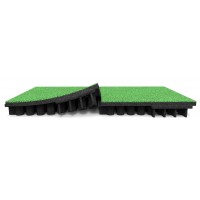Playground Surfacing Types

Source: 2.4 Surfacing
Public Playground Safety Handbook - CPSC Publication 325
U.S. Consumer Product Safety Commission
The surfacing under and around playground equipment is one of the most important factors in reducing the likelihood of life-threatening head injuries. A fall onto a shock absorbing surface is less likely to cause a serious head injury than a fall onto a hard surface. However, some injuries from falls, including broken limbs, may occur no matter what playground surfacing material is used. The most widely used test method for evaluating the shock absorbing properties of a playground surfacing material is to drop an instrumented metal head form onto a sample of the material and record the acceleration/time pulse during the impact. Field and laboratory test methods are described in ASTM F1292 Standard Specification for Impact Attenuation of Surface Systems Under and Around Playground Equipment. Testing using the methods described in ASTM F1292 will provide a “critical height” rating of the surface. This height can be considered as an approximation of the fall height below which a life-threatening head injury would not be expected to occur. Manufacturers and installers of playground protective surfacing should provide the critical height rating of their materials. This rating should be greater than or equal to the fall height of the highest piece of equipment on the playground. The fall height of a piece of equipment is the distance between the highest designated play surface on a piece of equipment and the protective surface beneath it. Details for determining the highest designated play surface and fall height on some types of equipment are included in Section 5 (Public Playground Safety Handbook - CPSC Publication 325) Parts of the Playground.
2.4.1 Equipment not covered by protective surfacing recommendations
The recommendations for protective surfacing do not apply to equipment that requires a child to be standing or sitting at ground level. Examples of such equipment are:
• Sand boxes
• Activity walls at ground level
• Play houses
• Any other equipment that children use when their feet remain in contact with the ground surface
2.4.2 Selecting a surfacing material
There are two options available for surfacing public playgrounds: unitary and loose-fill materials. A playground should never be installed without protective surfacing of some type. Concrete, asphalt, or other hard surfaces should never be directly under playground equipment. Grass and dirt are not considered protective surfacing because wear and environmental factors can reduce their shock absorbing effectiveness. Carpeting and mats are also not appropriate unless they are tested to and comply with ASTM F1292. Loose fill should be avoided for playgrounds intended for toddlers.
